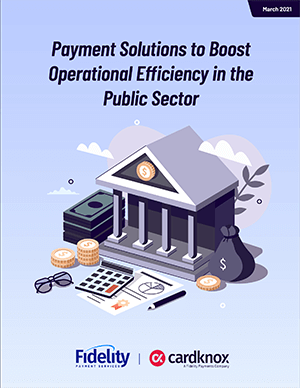By definition, the public sector is a part of the economy that is composed of public services controlled by the state. The types of organizations within this sector are quite varied, and some notable examples include police departments, public transit, utility offices, educational institutions, and more.

There are many reasons why government organizations need to collect payments. Oftentimes, these payments are for fees such as parking fines, speeding tickets, tax payments, fees to obtain public records or licenses, and other government-controlled expenses.
With the collection of payments serving such an integral role for many public sector organizations, the right payment processing technology can make all the difference for an organization’s efficiency, cash flow, and even reputation. Extensive organizational oversight and regulations coupled with limited budgets reinforce the need for public sector entities to implement payment processing solutions that cut costs, streamline recordkeeping and accounting, and reduce the number of missed payments from customers.
Compounding these organizational needs is the fact that customers today are increasingly opting for digital payment methods. Cash, checks, and money orders are quickly being replaced by ACH transfers and digital wallets like Apple Pay and Click to Pay. And for customers who pay in-person, contactless payments are becoming a preferred option.
In this white paper, we’ll dive into several challenges faced by today’s public sector organizations that relate to payment acceptance. Then, we’ll discuss some ways that payment technology, and particularly technology that’s powered by an integrated payment gateway, can address many—if not all—of these challenges.

Common Payment Processing Challenges Experienced by the Public Sector
From security concerns to tight budgets to cross-departmental inefficiencies, there are several challenges faced by public sector organizations that accept payments. Here’s a look at some of these roadblocks:
Fraud and Security Threats
The public sector is a prime target for fraudulent attacks and security breaches, many of which are attempts to expose financial data. In 2019, there were 6,843 public sector data security incidents, and 75% of these incidents were financially motivated.
Unfortunately, the Coronavirus pandemic has only made this worse. The term “cybercrime gold rush of 2020” was even coined to refer to the international surge in fraud. And for the public sector, this increase is, unfortunately, hitting quite close to home. Government stimulus payments and the small business Paycheck Protection Program both have been the target of fraudulent attacks. The Department of Justice reported an astounding $70 million in fraud losses from the first round of PPP funds in 2020.
Changing Customer Payment Preferences
More and more people across the country (around the world) are turning to digital forms of payment. Due to the change in payment methods, organizations within the government’s public sector are finding it necessary to comply with these changes if they want to stay up-to-date on the latest technological trends—and on a more basic level, to reduce the number of missed payments.
The days of writing checks or purchasing money orders are being replaced by online banking and bill pay. According to the National Automated Clearing House Association (Nacha), ACH payments and transfers initiated online surpassed $2 billion in 2020, a 15.2% increase year-over-year. At the same time, ACH payments initiated by check fell by more than 23%.
Besides ACH payments, mobile wallets like Apple Pay and Google Pay are becoming more common, both in-person and online. Those who are most likely to use mobile wallets are Millennials and Gen Z, making up 37% and 25% of the total mobile wallet market, respectively. According to Statista data, the number of people who chose to pay with mobile wallets jumped to 1.17 billion in 2020, growing by 29.6% year-over-year. By 2024, the value of this industry is expected to be $4.1 trillion.
By accepting a larger assortment of payment methods, government organizations are likely to reduce late payments and even increase the revenue they make by reducing the amount of defaulted debt. Offering more than one payment method increases the odds of consumers being able to pay those bills and fees.
High Payment Processing Costs
Many public sector organizations are burdened with high processing rates and complex rate structures that make budgeting a hassle. This poses quite the challenge since government organizations often have tight budgets that are subject to frequent oversight and auditing. For these organizations, finding a payment solution provider with competitive rates and transparent rate structures can make all the difference for their overall operations and bottom line. In particular, a service fee model that passes on processing costs to customers is a great way for government organizations to reduce their overhead costs.
Inefficient and Non-Integrated Systems
With competing demands and subjection to various regulations, public sector organizations have a lot to think about when implementing new payment processing solutions. They need to ensure that their payment solution is flexible enough to support a wide range of needs, allowing it to be integrated with their existing organizational management software. Doing so facilitates improved departmental oversight and a more streamlined accounting process.
The Benefits of a Payment Gateway for the Public Sector
A payment gateway brings public sector organizations the benefits of an integrated system along with highly-flexible card-present and card-not-present processing capabilities. With the help of a payment gateway, public sector organizations can appeal to the rapidly-changing payments landscape while saving on processing costs and improving data security.
Sola’s Payment Solutions for the Public Sector
Sola’s advanced payment gateway and extensive array of standalone payment processing solutions cater to government organizations and municipalities’ unique needs. With decades of industry experience, we’ve built up the technology and infrastructure to provide the public sector with optimized payment processing tools and competitive rates. Here are some of the many reasons why independent software vendors (ISVs) and their clients in the public sector have chosen Sola for their payment processing needs:
Advanced Security and PCI Compliance
Data security is of utmost importance for the public sector. Fortunately, our in-person and online processing solutions help organizations protect their data and stay compliant with the Payment Card Industry’s (PCI) Data Security Standards (DSS). In particular, our EMV processing integrations, advanced tokenization, support for P2PE-certified hardware, and online fraud screening tool help organizations in the public sector maintain the utmost level of security.
- EMV Chip Card Processing – Originating in Europe in 1993, EMV (Europay, Mastercard, and Visa) was a standard created by the card issuers to help fight card-present fraud. To encourage merchants to upgrade the technology, the card brands introduced the EMV liability shift in 2015. The EMV liability shift means that those merchants with upgraded systems would not be liable for fraudulent card activity as long as the magnetic strip or manual entry was not utilized during that transaction. EMV cards come with an integrated chip that communicates with the POS device or contactless terminal to authenticate the transaction. Every time the card is used, a unique code is produced that cannot be used again. Even if the hacker were to capture this code, they could not clone the EMV chip.
Sola has EMV integrations for both browser-based and cloud-based POS systems, making it easy to process EMV integrations no matter the existing setup. Additionally, our gateway is compatible with a wide range of EMV-ready payment terminals.
- Advanced Tokenization – Sola’s tokenization technology replaces sensitive card data with a randomly generated number so that fraudsters cannot intercept payment data during the processing cycle. In addition to protecting data during processing, Sola tokenization enables organizations to securely store customer payment information on file with.
- Compatibility With P2PE Solutions – Point-to-point encryption (P2PE) is a security standard created by the Payment Card Industry to ensure that card data stays secure during every step of processing. Sola supports many P2PE-certified terminals, which not only helps keep organizations safe but also simplifies PCI compliance.
- Built-In Fraud Screening – According to the Association of Certified Fraud Examiners (ACFE) 2018 Report to the Nations, organizations that implement preventive data monitoring detect fraudulent activity 58% faster with 52% lower losses. They state that the key to preventing financial fraud in the public sector’s organizations is implementing fraud detection and a robust data analytics strategy.
Sola’s fraud screening tool scans all incoming online orders for indicators of fraud, and it provides a simple Yes or No answer. It has the highest automated approval ratio of any fraud protection program to prevent an unnecessary drop in sales, and it offers 100% chargeback protection in the case of fraudulent transactions that were approved.
Advanced Security and PCI Compliance
Sola’s extensive experience with organizations in the public sector allows us to offer our clients the lowest rates. We offer both a traditional pricing model and a service fee program developed just for the public sector.
Our service fee program enables organizations to charge a fixed flat-rate fee or a percentage-based fee to each transaction in order to offset the costs of credit card processing. As more and more customers prefer to pay with a card online rather than send in a check, the service fee program is a great solution for organizations that want to accept credit cards while keeping costs low. Most consumers are willing to pay a small fee for the convenience of using their credit card rather than having to withdraw cash or write a check. And, in addition to lowering processing costs and improving the customer experience, our service fee program streamlines the approval process for organizations that need approval from city councils on fiscal matters.
Organizations who opt for our traditional pricing model can rest assured that we offer the most competitive rates. Our in-house pricing experts know how to set up processing accounts in a way that keeps costs low, while our interchange qualification monitoring (IQM) technology automatically routes each transaction for the lowest rates.
Seamless Integrations with Public Sector Software
No payment integration is too complex for Sola to handle. The Sola gateway can be easily integrated with many public sector software programs to improve organizational operations. A Sola integration with public sector software will streamline account reconciliations and improve the transparency of payment information among various departments—all while maintaining utmost security.
Powerful Transaction Reporting in the Sola Merchant Portal
The Sola Merchant Portal makes monitoring payment activity easy. This user-friendly virtual terminal provides organizations with advanced reporting capabilities for all their transactions processed in-person and online. Users can choose from a preset report option, or they can create a custom report. In addition to its reporting capabilities, the Sola Merchant Portal allows users to key n one-time or recurring transactions, safely store customer payment information, send email invoices, and much more.
The centralized platform makes it possible to keep all departments within an organization in sync with one another. A single organization can set up multiple accounts and access them all through one set of login information. Plus, multiple users can be added to each account with varying levels of access to different features.
Online, In-Person, and Over-the-Phone: Processing Solutions for Public Sector Organizations
Sola offers an array of payment processing options that cater to a wide range of needs and use cases:
- In-Person Payment Processing
Sola supports an extensive array of payment terminals for accepting card payments in-person. These terminals provide reliable and fast payment processing, and they give customers a choice to pay how they’d like: with EMV, magnetic stripe, or contactless payment methods. - Online Payment Processing
For many public sector organizations, card-not-present solutions are ideal for processing fees and invoices. Sola can support this need in a variety of ways:- E-Commerce Integrations – convenient and secure plugins allow for payments through popular e-commerce platforms like Magneto, WooCommerce, and more. We offer a full gateway integration using our SDK.
- PaymentSITE – Sola’s PaymentSITE online form can be embedded into an existing web page or set up as a standalone web page to collect ACH or card payments online. Through the Sola Merchant Portal, organizations can customize their PaymentSITE’s layout and display or even add fields that prompt the payee to sign up for a recurring payment.
- Sola Merchant Portal – This web-based application gives Merchants the option to key-in ACH or card information for one-time or recurring transactions. Users can also void, refund, or adjust transactions as needed.
- Over-the-Phone Payment Processing
Sola PhonePay is an interactive voice response system that enables customers to make payments over the phone 24/7. With this fully-automated solution, customers who dial into the organization’s unique PhonePay line can follow the prompts to input their payment information. PhonePay is a great option for organizations that would like to collect payments via text, as the PhonePay number can be easily texted to customers with outstanding balances.
Support for a Wide Range of Payment Methods
As discussed above, the payments landscape is rapidly changing, and customers appreciate having options to pay how they want. Sola supports the following payment methods for in-person, online, and over-the-phone payments:
Card Payments: With Sola, organizations can accept EMV, magnetic stripe, and contactless cards.
ACH: Sola supports ACH payments for both one-time and recurring payments. This method is becoming increasingly popular and the preferred payment method due to its convenience and fast funding. When receiving payments through ACH, the organizations don’t have to worry about sending out invoices through the mail or taking checks to the bank to deposit.
Contactless Payments: With the current virus outbreak, consumers and organizations are rapidly changing how they handle business to remain as safe as possible. One way that Sola is facilitating this is through the use of contactless payment options. Sola makes it easy to accept contactless payments through seamless payment solutions that can be used in-store, online, and through mobile phones.
Mastercard reported a 40% jump in contactless transactions during the first quarter of 2020. The new payment preference has been brought on by recommendations of higher government agencies. Even the State of New Jersey mandated that businesses arrange to accept contactless payments when possible.
Mobile Wallets: Sola supports mobile wallets like Google Pay and Apple Pay for both in-person and online payment processing platforms. Especially as more and more people access the internet from mobile devices, accepting mobile wallets is a great way for organizations to provide a more mobile-friendly bill pay experience.
Recurring Payment Processing
Since many public sector organizations charge recurring bills, Sola’s recurring payment solution will be sure to simplify this task. Whether it’s for utility payments, charitable donations, or tuition, Sola’s recurring payment processing feature can increase cash flow, offer a reduction in invoicing costs, and reduce the number of collection calls required for late or missed payments.
Organizations can easily manage Recurring payments through the Sola Merchant Portal. Portal users can securely store customer payment information and set up custom schedules that specify the desired payment amount, frequency, payment method, and more.
To prevent declined transactions on scheduled payments, Sola has an Account Updater tool that scans all cards stored on file in order to locate and update any that are expired or inactive. This feature helps reduce missed payments while eliminating the need for organizations to chase after their customers for payments.
The Sola Advantage
Government organizations can benefit tremendously from Sola’s products and services. With Sola, you can expect the highest level of security, satisfaction, and access to convenient payment options. Let Sola integrate your current system to allow for payment acceptance across platforms and through a variety of payment methods.
If you’re an ISV, know that a partnership with Sola is truly unmatched. You’ll enjoy easy, round-the-clock access to our Developer Support team, the most flexible SDK, and future-ready technology. Contact us to learn more.
















